

|
|
#16 |
|
Tomatovillian™
Join Date: Oct 2009
Location: OKLAHOMA
Posts: 26
|
im still tryin to grow peppers like that!!! those look great mvan!!
|
|
|

|
|
|
#17 |
|
Tomatovillian™
Join Date: Feb 2006
Location: Den of Drunken Fools
Posts: 38,539
|
I bet he bought em from the store.
 Worth |
|
|

|
|
|
#18 |
|
Tomatovillian™
Join Date: Feb 2009
Location: Fairburn, GA z7
Posts: 72
|
Buy them from the store? Are you kidding. They want an arm and a leg for green peppers, let alone any that have color to them....
But it did take me about 25 plants and all season to get those peppers... |
|
|

|
|
|
#19 | |
|
Tomatovillian™
Join Date: Aug 2009
Location: Slovenia, Europe zone 7b
Posts: 300
|
Quote:
I really think high temperature can't be problem, but high humidity can be. Bulgaria an Macedonia have summer temps like yours, but low air humidity and their bell peppers are wonderful. I have an old gardening book that says peppers like dry heat an wet feet. |
|
|
|

|
|
|
#20 | |
|
Tomatovillian™
Join Date: Feb 2006
Location: Den of Drunken Fools
Posts: 38,539
|
Quote:
 That's what really good meat costs. On top of that It's just a lousy bell pepper. They must raise these babies in a hospital under intensive care with nurses watching over them around the clock. I can hear it now--CODE BLUE--CODE BLUE--nitrogin levels high on Big Bertha. Bring 27 mil phosphorus STAT.  Worth |
|
|
|

|
|
|
#21 |
|
Tomatovillian™
Join Date: Feb 2006
Location: Warm Springs, GA
Posts: 1,421
|
My advice for pepper growers is.
Start your plant early in warmer zones like 8, 9. Get your plants going as soon as you can. Plan on getting a good amount of peppers in the summer but really  your big crop will be SEPTEMBER and OCTOBER. I like to make sure my peppers have some afternoon shade. I grow the biggest, thickest ones in the shade of an Oak tree. I do give them lots of food but somewhere I read years ago that phosphate was the key to growing good peppers. I do make sure they get extra. your big crop will be SEPTEMBER and OCTOBER. I like to make sure my peppers have some afternoon shade. I grow the biggest, thickest ones in the shade of an Oak tree. I do give them lots of food but somewhere I read years ago that phosphate was the key to growing good peppers. I do make sure they get extra. 
|
|
|

|
|
|
#22 |
|
Tomatovillian™
Join Date: Jan 2006
Location: Northern Minnesota - zone 3
Posts: 3,231
|
I am a bit puzzled that people further south of me are having a hard time growing decent peppers. I figured my short season with often cool early summer was pretty tough on peppers, but I usually can get pretty decent full sized thick wall sweets most years, though some years not too many have time to turn red. My methods might not work for others in different growing zones.
I don't do anything special, other than to start my seeds about two weeks before I start my tomatoes, and pot them up several times if need be, to keep the roots from stunting in too small pots before setting out. I'd rather pot up an extra time than put them into the cold ground. I don't mulch because my problem here is keeping the ground warm. I could probably do even better by using black plastic, but I don't like the looks of it. I don't have reliable watering help when we are gone or I might grow some in pots. My peppers each get a shovel of rotted manure under the plant when setting out, and maybe one or two doses of generic blue juice a few weeks apart while the plant is still actively growing and setting blossoms. I don't bother removing any blossoms. I get blossums drop by itself if conditions are too chilly or poor, and with my short season, even one big developed pepper per plant works for me. I really can't say whether leaving blossoms on stunts the plant or not. I've had some puny plants that only produced one or two peppers, and never did put on much height over the summer. Yet some from the same batch of seeds kept growing tall, producing and continuing to set peppers til frost in the fall. I've never timed how long it takes the plant to develop new blossoms after the old ones are removed, but I'm guessing one to two weeks. That isn't a big deal to you folks with long growing seasons, but two weeks is half a month lost to me = a big deal here.  I 've always had good luck with a hybrid I get from TGS called Big Early - it's a thick walled elongated type. 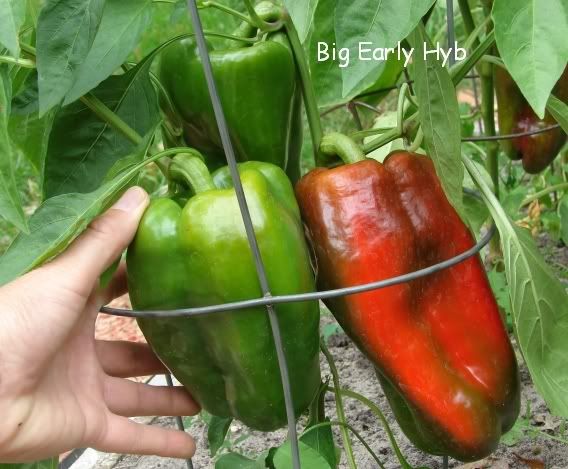 Here are some I grew in 2007 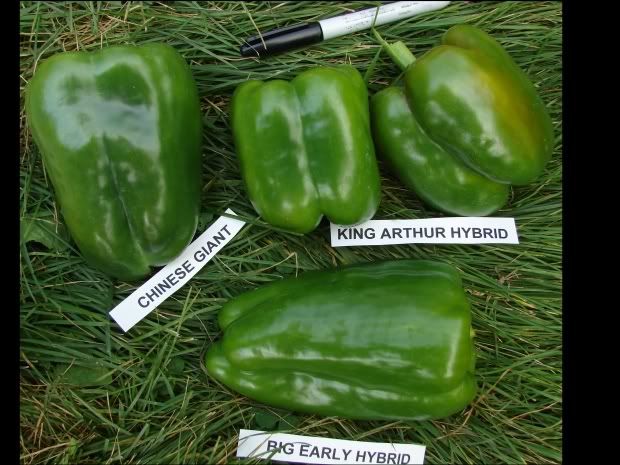 And I've had good luck with Gabriel's Red for a few years. 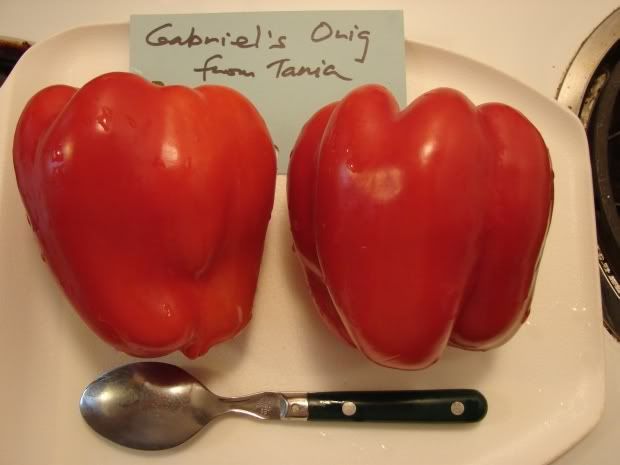 I don't have the season length to get huge production from any one plant, so I make up for that growing more plants. And I do grow a variety of smaller or frying type sweets as well. 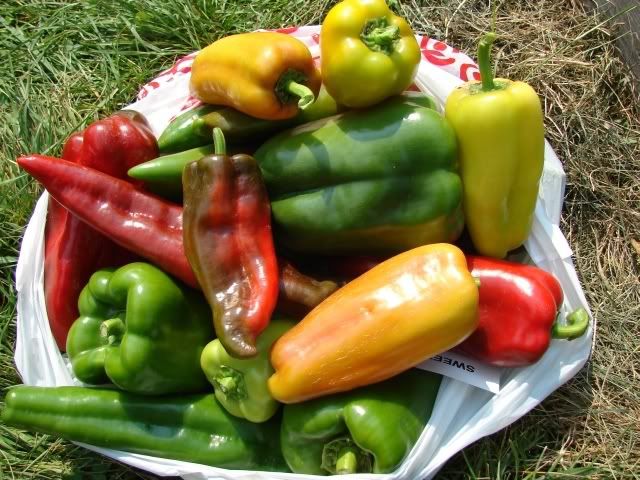
__________________
Dee ************** |
|
|

|
|
|
#23 |
|
Tomatovillian™
Join Date: Dec 2009
Location: USA
Posts: 1,013
|
I can't speak for all in the south as there are so many different soils and regional climates, but my problem here has simply been one of size and wall thickness. That said, I have mostly relied on the varieties available through the retail chains...all of which come from the same plant farms. Though advertised with names that imply large sizes, mine have generally been very thin walled and very small fruits...not worth the effort. This year I will grow my own, while seeking varieties suited to our conditions. With tomatoes, sun scald is an equally constant problem. It's a pitiful sight to see tomatoes cooked on the vines.
|
|
|

|
|
|
#24 |
|
Tomatovillian™
Join Date: Jan 2006
Location: Montana
Posts: 1,038
|
The best years here for sweet peppers are always the cooler summers...The hotter , drier years really reduce quantity and quality of sweet peppers...the hot ones seem to not be as fussy...
Jeanne |
|
|

|
|
|
#25 |
|
Tomatovillian™
Join Date: May 2009
Location: Wisconsin
Posts: 985
|
Wow, Ddsack, those are beautiful peppers. What is the variety that is in the 4th picture and is an elongated yellow?
I'm in Wisconsin and have had trouble growing peppers. I think one thing is that I start them too late and they are not mature enough when I plant them. Also, is there a really good catalog for peppers? Thanks for any replies. |
|
|

|
|
|
#26 |
|
Tomatovillian™
Join Date: Jan 2006
Location: Northern Minnesota - zone 3
Posts: 3,231
|
Farmette, I can't be 100% sure since that photo was taken a while ago, and was just meant to be a jumble of peppers, but I think that the yellow pepper you are referring to is probably a Gypsy Hybrid.
Here's comparison shot of some smaller non-Bell sweets that I have grown. Gypsy is about the earliest maturing, and can be eaten yellow, but is really nice if you let it get the orange cast. 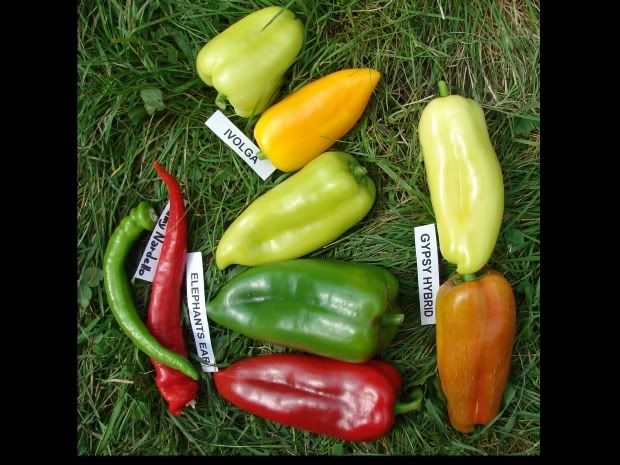 For no particular reason, I tend to get most of my peppers from Tomato Growers Supply catalog and usually have luck with their seeds. I don't experiment as much with peppers as I do with tomatoes, sticking with my tried and true varieties with only a couple of new ones each year. A few varieties, I have gotten in trades. I hope other people will chime in with their favorite pepper sources, I'd like to know that too.
__________________
Dee ************** |
|
|

|
|
|
#27 | |
|
Tomatovillian™
Join Date: Apr 2009
Location: South Carolina Zone 8a
Posts: 1,205
|
Quote:
Decent peppers aren't the problem. Decent bell peppers are. It's a question of temperature and disease. It's certainly warmer here. Way warmer. Way, way warmer. So, while your cool summers are of concern to you, my concern is hot summers. And I'm not even "further-est south" of you. Too, I could probably grow a decent crop of bell peppers were I willing to spray or otherwise coddle them, but why bother? There are better tasting and hardier peppers to be had, ones that show resistance to the diseases endemic to the Great Mildew State and that don't mind the heat so much. I find the Italian heirlooms and pimento types hardier and better tasting. Chile peppers are even hardier, for the most part, with lots of interesting tastes, not just boring old "sweet". So, I grow even more of them than sweet peppers. |
|
|
|

|
 |
|
|
